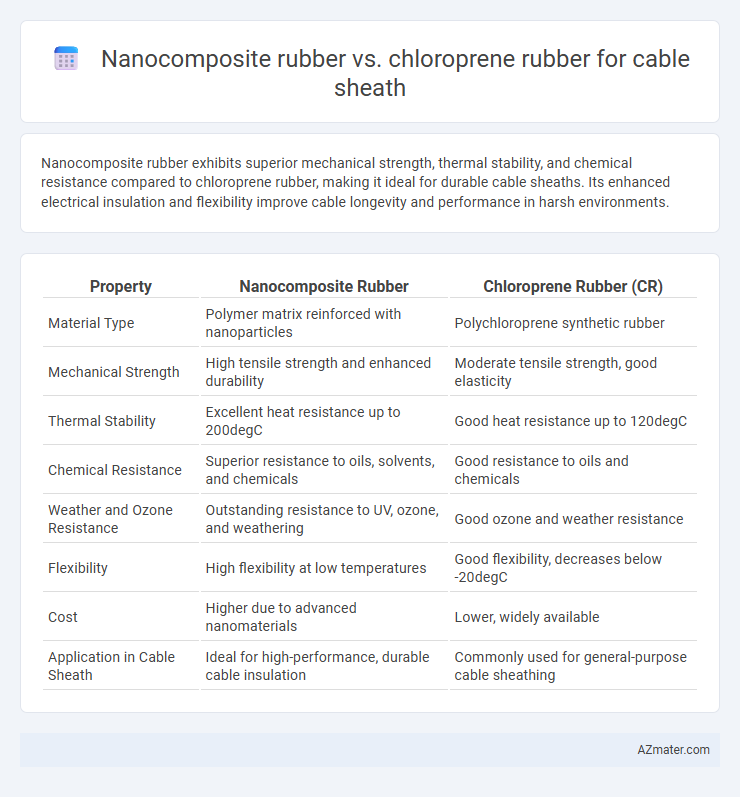Nanocomposite rubber exhibits superior mechanical strength, thermal stability, and chemical resistance compared to chloroprene rubber, making it ideal for durable cable sheaths. Its enhanced electrical insulation and flexibility improve cable longevity and performance in harsh environments.
Table of Comparison
| Property | Nanocomposite Rubber | Chloroprene Rubber (CR) |
|---|---|---|
| Material Type | Polymer matrix reinforced with nanoparticles | Polychloroprene synthetic rubber |
| Mechanical Strength | High tensile strength and enhanced durability | Moderate tensile strength, good elasticity |
| Thermal Stability | Excellent heat resistance up to 200degC | Good heat resistance up to 120degC |
| Chemical Resistance | Superior resistance to oils, solvents, and chemicals | Good resistance to oils and chemicals |
| Weather and Ozone Resistance | Outstanding resistance to UV, ozone, and weathering | Good ozone and weather resistance |
| Flexibility | High flexibility at low temperatures | Good flexibility, decreases below -20degC |
| Cost | Higher due to advanced nanomaterials | Lower, widely available |
| Application in Cable Sheath | Ideal for high-performance, durable cable insulation | Commonly used for general-purpose cable sheathing |
Introduction to Cable Sheath Materials
Cable sheath materials play a crucial role in protecting electrical cables from environmental damage and mechanical stress, ensuring safety and durability. Nanocomposite rubber enhances traditional properties by incorporating nanoparticles that improve thermal stability, abrasion resistance, and electrical insulation, outperforming conventional chloroprene rubber. Chloroprene rubber, known for its excellent weather resistance, flexibility, and moderate chemical resistance, remains widely used but often falls short in advanced performance criteria required for modern cable applications.
Overview of Nanocomposite Rubber
Nanocomposite rubber incorporates nanoscale fillers such as carbon nanotubes, nanoclays, or graphene to enhance mechanical strength, thermal stability, and electrical insulation properties essential for cable sheaths. These nanofillers create a reinforced polymer matrix that significantly improves wear resistance, flexibility, and barrier performance compared to traditional chloroprene rubber. The advanced dispersion of nanoparticles in nanocomposite rubber leads to superior durability and longer lifespan in harsh environmental conditions for cable protection.
Understanding Chloroprene Rubber Properties
Chloroprene rubber exhibits excellent weather resistance, mechanical strength, and flame retardancy, making it a preferred material for cable sheaths exposed to harsh environments. Its inherent resistance to oil, ozone, and abrasion enhances the durability and longevity of cable insulation in industrial applications. Compared to nanocomposite rubber, chloroprene rubber offers balanced elasticity and thermal stability, crucial for maintaining sheath performance under varying temperature conditions.
Mechanical Performance Comparison
Nanocomposite rubber exhibits superior mechanical performance compared to chloroprene rubber for cable sheath applications, offering enhanced tensile strength, abrasion resistance, and elongation at break due to the uniform dispersion of nanoscale fillers within the polymer matrix. Chloroprene rubber, while providing good weather resistance and moderate mechanical properties, typically underperforms in durability and tensile metrics relative to nanocomposite formulations. The incorporation of nanoparticles in nanocomposite rubber results in improved load transfer efficiency and crack resistance, making it more suitable for high-stress cable sheath environments.
Thermal Resistance: Nanocomposite vs Chloroprene Rubber
Nanocomposite rubber exhibits superior thermal resistance compared to chloroprene rubber, maintaining structural integrity and performance at elevated temperatures exceeding 150degC. The incorporation of nanoscale fillers in nanocomposites enhances heat dissipation and reduces thermal degradation, extending the cable sheath lifespan under harsh conditions. Chloroprene rubber typically withstands temperatures up to 120degC but degrades faster under prolonged thermal stress, limiting its application in high-temperature environments.
Electrical Insulation Characteristics
Nanocomposite rubber exhibits superior electrical insulation properties compared to chloroprene rubber for cable sheath applications, offering enhanced dielectric strength and reduced electrical conductivity due to uniformly dispersed nanofillers. The incorporation of nanoparticles in nanocomposite rubber improves barrier properties and minimizes the risk of electric breakdown, ensuring longer cable lifespan under high-voltage conditions. Chloroprene rubber, while durable and flexible, generally shows lower dielectric resistance and higher electrical loss, making nanocomposite rubber a more reliable choice for advanced cable insulation systems.
Durability and Environmental Resistance
Nanocomposite rubber for cable sheaths offers enhanced durability through improved tensile strength and abrasion resistance compared to traditional chloroprene rubber, resulting in longer service life under mechanical stress. Its nanofiller-reinforced structure provides superior environmental resistance, including better protection against UV radiation, ozone, and chemical exposure, which are common degradation factors in outdoor cable applications. Chloroprene rubber, while known for good overall weather resistance, typically exhibits lower longevity and diminished performance in harsh environmental conditions compared to nanocomposite alternatives.
Cost-Effectiveness and Material Availability
Nanocomposite rubber offers enhanced durability and performance for cable sheaths but generally comes at a higher cost due to advanced materials and manufacturing processes. Chloroprene rubber, widely available and cost-effective, provides reliable weather and chemical resistance suitable for most standard cable applications. Considering material availability and budget constraints, chloroprene rubber remains the preferred choice for large-scale cable sheath production where cost-effectiveness is critical.
Application Suitability in Cable Sheathing
Nanocomposite rubber exhibits enhanced mechanical strength, thermal stability, and superior electrical insulation properties, making it highly suitable for high-performance cable sheathing applications in demanding environments. Chloroprene rubber (CR) offers excellent resistance to weathering, ozone, and flame, which is advantageous for outdoor and industrial cable sheaths but may lack the advanced durability benefits of nanocomposites. Choosing nanocomposite rubber improves longevity and flexibility in complex electrical systems, while chloroprene rubber remains preferred for cost-effective, robust protection under moderate conditions.
Future Trends in Cable Sheath Materials
Nanocomposite rubber offers enhanced mechanical strength, thermal stability, and improved electrical insulation compared to traditional chloroprene rubber, positioning it as a leading future trend in cable sheath materials. Innovations in nanofillers like graphene and carbon nanotubes are driving advancements in durability and flame retardancy, crucial for next-generation high-performance cables. Research is focused on scalable manufacturing processes for nanocomposite rubbers to meet growing demands in electric vehicles, renewable energy, and smart grid applications.

Infographic: Nanocomposite rubber vs Chloroprene rubber for Cable sheath
 azmater.com
azmater.com